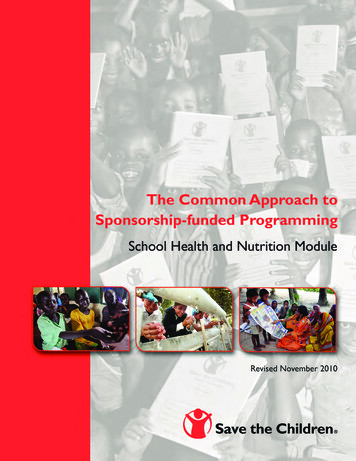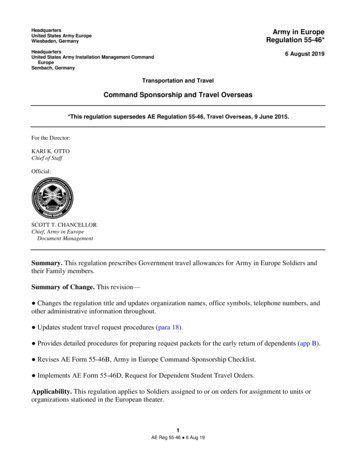
Transcription
ContentsACRONYMS USED IN THIS MODULE3INTRODUCTION TO THE COMMON APPROACH SCHOOLHEALTH AND NUTRITION MODULEStep 3:Monitoring and Evaluation Plan Design37Step 4:Baseline Data Collection39Step 5:Implementation and Monitoring43Implementing your program43Monitoring and reporting on your progress434About the Common Approach to Sponsorship-fundedProgramming4Step 6:Evaluation45How to Use this Module5Step 7:Lessons Learned477ANNEXESABOUT SCHOOL HEALTH AND NUTRITION PROGRAMS49What are School Health and Nutrition Programs?7Annex 1: Suggested Outline for a Situational Analysis Report 49Why invest in School Health and Nutrition Programs?7Annex 2: Example of a Results Framework that IntegratesSHN and BEThe International Framework for School Health and NutritionPrograms1050Annex 3: SHN Indicator Reference Sheet51Save the Children’s Approach to School Health and Nutrition 10Annex 4: Key Strategies Matrix55Key Principles of SHN Programming12Annex 5: List of Resources61School Health and Nutrition and Links to Other Programs13TABLE OF FIGURESTHE COMMON APPROACH TO SCHOOL HEALTH ANDNUTRITION PROGRAMMINGStep 1: Situational AnalysisFigure 1: The Common Approach Program Cycle16Figure 2: School Health and Nutrition Results Framework63017The purpose of a situational analysis17How to do a situational analysis17Box 1:Burden of ill-health in school-age children20Box 2:The Theory of Change1129Box 3:Important considerations for data collection andmanagement19Key questions to guide a situational analysisStep 2: Program DesignWhat is a results framework?29Selecting strategies for your program34Completing the Summary Implementation Plan35Cover photos (back, then front left to right):Malawi, photo by Michael Bisceglie; South Sudan, photo by Jenn Warren;Tajikistan, photo by Chris Martin; Bangladesh, photo by Jeff Holt.TABLE OF BOXES9
Acronyms used in this module:ADAdolescent DevelopmentBEBasic EducationCACCommunity Action CycleCMCommunity MobilizationCOCountry OfficeCRCConvention on the Rights of the ChildDHSDemographic and Health SurveyDM&E Design, Monitoring and EvaluationECCD Early Childhood Care and DevelopmentEFAEducation for AllFGDFocus Group DiscussionsFRESH Focusing Resources on Effective School HealthIDAIron Deficiency AnemiaIDDIodine Deficiency DisordersIRIntermediate ResultMoEMinistry of EducationMoHMinistry of HealthM&EMonitoring and EvaluationNGONon-governmental OrganizationNTDNeglected Tropical DiseasesOVCOrphans and Vulnerable ChildrenPITProcess Indicator ToolPTAParent-Teacher AssociationRIPTResults Indicator Planning ToolSHNSchool Health and NutritionSMCSchool Management CommitteeSTWG Sponsorship Technical Working GroupSOStrategic ObjectiveSTHSoil-transmitted HelminthsTATechnical AssistanceVADVitamin A DeficiencyWASH Water, Sanitation and HygieneSCHOOL HEALTH AND NUTRITION MODULE3
Introduction to the Common ApproachSchool Health and Nutrition ModuleAbout the Common Approach to Sponsorship-fundedProgrammingFunds raised through marketing sponsorship products (e.g. individual and representative child sponsorship) areallocated to specific country offices (COs) to implement sponsorship-funded programs.These programs aim toensure that children are educated and healthy through the use of a proven approach to design, implementationand measurement, known as “The Common Approach to Sponsorship-funded Programming” or “the CommonApproach.”1The goal of the Common Approach is for country offices to successfully design, implement, monitor and evaluatetheir sponsorship-funded programs.The Common Approach framework has seven key components:1.A focus on select programs in which Save the Children has extensive experience and expertise, and thatcoincide with the age range of sponsored children.These are called the sponsorship “core programs”2and consist of:a.Early Childhood Care and Development (ECCD)b.Basic Education (BE)c.School Health and Nutrition (SHN)d.Adolescent Development (AD)2.Guidance and tools for each of these programs documented in core program modules, including this one.3.Standard supporting guidance and tools for design, monitoring and evaluation (DM&E), which aresummarized in this module (detailed guidance can be found in the Common Approach DM&E Module).4.Adherence to a common program cycle.5.The provision of consistent, quality program technical assistance (TA) by the members of theSponsorship Technical Working Group (STWG).6.Mechanisms through which we can learn from experience and use this information to make programimprovement.7.Use of a proven approach for mobilizing communities, documented in the Sponsorship CommunityMobilization Compendium: Mobilizing Communities for Education, Health and Social Change.This module draws on all seven of these components and provides guidance on how to design, implement, monitorand evaluate your sponsorship-funded SHN program.12The acronym “CASP” is sometimes also used to refer to The Common Approach to Sponsorship-funded Programming.Country offices must invest a minimum of 75 percent of their sponsorship program resources in one or more of these core program areas.SCHOOL HEALTH AND NUTRITION MODULE4
n hereSponsorship-funded Programs and InnovationAt the heart of the Common Approach framework is the implementation of quality, evidence-based programs.However, there is flexibility within the framework to allow for innovation. Sponsorship funds can be used to pilotand evaluate cost-efficient innovative interventions and/or approaches that seek to best address children’s positivegrowth and development. Successful innovations can then be shared with other Save the Children COs, and scaledup through hand-over to the government, additional donor funds or partnership with others.The implementationof any innovation should be done in close coordination with the program’s STWG TA provider.How to Use this ModuleThe module is divided into two main sections:1. About School Health and Nutrition Programs: This section provides the rationale for SHN andintroduces the Focusing Resources on Effective School Health (FRESH) international framework for SHNprogramming. It also includes Save the Children’s experience and approach to SHN programming; outlineskey principles that should guide all Save the Children SHN programs; and highlights the important linksSHN programs must make with Save the Children’s other sponsorship-funded programs as well asprograms outside Save the Children.2. The Common Approach to School Health and Nutrition Programming: This second sectionwalks you through each of the seven steps of the Common Approach program cycle (see Figure 1), withSHN-specific guidance provided for each step. Particular emphasis is placed on the situational analysis andprogram design steps.The seven steps are summarized below: Step 1: Situational Analysis. A situational analysis must be conducted prior to designing an SHNprogram in an impact area. It involves collecting and analyzing information to identify and define keyproblems that can be addressed by an SHN program. Step 2: Program Design. Once information on the needs and resources of the targetcommunities are available from the situational analysis, this information should then be used todesign an SHN program.To help design the SHN program, the SHN results framework in thismodule can be used to help determine the end results you seek from SHN programming in yourcountry context. Once you’ve identified the results you seek, you’ll need to select the strategies(interventions) for achieving those results.The Key Strategies Matrix in this module will help youweigh options and choose the interventions appropriate for your country context. As a last step tocompleting the program design, a Summary Implementation Plan must be prepared. Step 3 & 4: Monitoring and Evaluation (M&E) Plan Design and Baseline DataCollection. Prior to implementation, draft an M&E plan based on the program design, identify keyindicators to measure program progress over the life of the program, and document your ImpactArea Presence Plan. Collect baseline data and produce a comprehensive baseline report. Step 5: Implementation and Monitoring. In this step you will undertake all activities requiredto implement and monitor the SHN program. A Results Review should be organized every sixmonths so that program staff and implementing partners can discuss program progress, identifygaps and plan next steps to improve the program accordingly. Key references are provided to helpyou with this step.SCHOOL HEALTH AND NUTRITION MODULE5
Step 6 & 7: Evaluation and Lessons Learned. Midway through the program, and close to theend of the planned presence in the impact area, a program evaluation must be conducted to assessif the program has been effective in improving the health, nutritional and educational outcomes ofchildren. Every program follows a different timeline for when evaluations take place; however,every three to four years is recommended for most SHN programs. A Lessons Learned workshopshould be conducted after each evaluation at least, and most importantly, close to the end of theprogram, prior to phase-in to a new impact area. A Lessons Learned workshop provides allstakeholders associated with the program the opportunity to discuss program results, identify keysuccesses and challenges faced during the life of the program, as well as strategies that worked welland should be continued.This module is intended to serve as a reference and guide for CO program technical staff andis to be supplemented by technical assistance from the CO’s STWG TA providers. In addition,the Common Approach DM&E Module and the Sponsorship Community Mobilization Compendium shouldbe read alongside this core program module.The DM&E Module contains many helpful tools and in-depthexplanations about each step of the program cycle, with a particular emphasis on the steps that follow thesituational analysis and program design.The Sponsorship Community Mobilization Compendium providesdetailed guidance on how to implement the Community Action Cycle (CAC).The phases of the CAC, andhow they relate to each program cycle step, are presented in abbreviated form in this core programmodule.Figure1: The Common Approach Program CycleSituational AnalysisLessons LearnedEvaluationProgram DesignTheProgramCycleImplementation& MonitoringM&E Plan DesignBaselineThe Common Approach emphasizes that programs must be designed, monitored and evaluatedaccording to a standard process. This process is guided by adherence to a standardized program cycle.SCHOOL HEALTH AND NUTRITION MODULE6
About School Health and Nutrition ProgramsWhat are School Health and Nutrition Programs?School Health and Nutrition programs are health and nutrition interventions that are implementedthrough schools and targeted at school-age children (approximately five to 12 years) so that they improvetheir health and nutritional status, behaviors and skills, and are able to participate in and complete theireducation.Why invest in School Health and Nutrition Programs?1. To improve children’s health, their learning in school and educational outcomes.School-age children are often thought of as healthy, but studies have shown that they face high levels ofillness and malnutrition as they go through these crucial growing years. In some of the neediest countries,school-age children face high morbidity from preventable diseases, which decrease their cognitivedevelopment, intellectual capacity, and overall growth (see Box 1 on the burden of ill-health in school-agechildren). Children are sometimes too weak or sick to go to school and often cannot pay attention duringa full schedule of classes. Many perform poorly on school tests, repeat grades or drop out of schoolaltogether, failing to attain the basic skills that may help them lead healthier and more productive lives inthe future.The World Declaration on Education for All identifies poor health and malnutrition as one ofthe key challenges to promoting quality primary education for all children.Maintaining children’s health is therefore essential for their cognitive development, growth, and learning, andfor ensuring quality Education for All. Research has shown that school-based health and nutrition programsimprove children’s health and nutrition, in turn leading to increased enrollment, attendance, reduced classrepetition and increased educational attainment. For example, micronutrient supplementation anddeworming have been shown to improve school performance and restore intelligence quotient (IQ) lossesof up to 21 points. Hygiene and sanitation promotion in schools is known to improve children’s health,boost school attendance and improve gender equity.32. To meet children’s basic rights to education and health.SHN programs support the basic human rights included in the Convention on the Rights of the Child(CRC), especially those related to the highest attainable standard of health (Article 24) and the right toeducation for the development of children to their fullest potential (Articles 28 and 29). Children haverights to information, education and services; to the highest attainable standard of physical and mentalhealth; and to formal and non-formal education about population and health issues, including sexual andreproductive health issues. Access to clean water and adequate sanitation facilities is also a fundamentalright to safeguard health and human dignity. SHN programs offer a unique opportunity to help meet theserights. Effective SHN programs ensure that schools are safe and protected (free from abuse, corporalpunishment and harassment) and ensure children’s participation in education at all levels.Jukes, M C H., et al (2008). School Health, Nutrition and Education for All: Levelling the Playing Field. Home Grown School Feeding. Download from:http://www.hgsf-global.org/en/policy.3SCHOOL HEALTH AND NUTRITION MODULE7
3. To meet new opportunities and unfulfilled needs.Global and national initiatives to improve child survival and achieve universal access to basic educationmean that more children now have the opportunity to go to school. As a result, schools are now a keysetting where the education and health sectors can jointly take action to improve and sustain the health,nutrition and education of children previously not reached, especially girls.4. To enhance equity in education.Children who begin school with the worst health status have the most to gain from health and nutritionprograms.They also have the most to gain educationally, since they show the greatest improvement incognition as a result of health interventions.Thus, SHN programs particularly benefit the poor and thedisadvantaged.These children are increasingly accessible through schools as a result of universal educationstrategies.Although girls are more disadvantaged than boys in terms of school enrollment and completion, more girlsattend schools than ever before. School-based health interventions have the capacity to reach more girlsthan are being reached through existing health services thus improving their health. Moreover, education ingeneral protects girls from risky behaviors, delays their pregnancy, prevents HIV/AIDS and improves theiroverall health, and SHN programs ensure that they are able to complete schooling and improveeducational performance. Similarly, improvements to sanitation facilities in schools, such as separate latrinesfor girls, attract more girls to school since schools are perceived as safer and more adapted to their needs,encouraging parents to enroll and keep their daughters in school.5. To build on investments in early childhood.An increasing number of countries have recognized the need to ensure good health and developmentduring the most vulnerable early years of life. Integrated management of childhood illness, early childhooddevelopment, and growth monitoring and promotion programs all help to ensure that a child entersschool fit, well and ready to learn. But the school-age child continues to be at risk of ill health, and thehealth of children often deteriorates during the school years. SHN programs ensure that children remainhealthy during the years that are critical for education.6. To promote adolescent development.Children form attitudes and beliefs early in life and are more likely to practice healthy behaviors if they areestablished as habits at an early age. Schools offer the best venue to reach young children and youth withage-appropriate messages on healthy behaviors in order to tackle some major problems of adolescence:violence, substance abuse, teenage pregnancy and sexually transmitted diseases, including HIV/AIDS. Asprimary education enrollment rates rise, schools are also an effective venue for communicating messageswhich can be disseminated throughout the entire community.7. To invest cost-effectively in health and education.SHN programs help link the resources of the health, education, nutrition and sanitation sectors in aninfrastructure – the school – that is usually already in place.The school system’s coverage is extensive andit has a skilled workforce that already works closely with communities.The existence of this infrastructuremeans program costs can be low, and if well-designed, SHN programs can be amongst the most costeffective of public health interventions. Generalized treatment approaches such as mass deworming ormicronutrient supplementations, which do not rely on selective treatment based on individual diagnosis, areparticularly cheap: annual deworming is estimated to cost only US 0.20- 0.30 per child per year; vitamin Asupplementation, US 0.04; and a course of iron folate supplements only US 0.10.SCHOOL HEALTH AND NUTRITION MODULE8
hereBox 1: Burden of ill-health in school-age children4567891011 53 percent of school-age children suffer from Iron Deficiency Anemia (IDA), the major healthconsequences of which are impaired physical and cognitive development, as well as increasedmorbidity from infectious diseases.4 60 million or five percent of all school-age children suffer from iodine deficiency. 5 IodineDeficiency Disorders (IDD) can start before birth and jeopardize children’s mental health as wellas their survival. Often, IDDs can lead to less visible, yet pervasive, mental impairment that reducesintellectual capacity at home, school and work. Approximately 85 million or seven percent of all school-age children lack sufficientvitamin A.6 Long-term vitamin A deficiency (VAD) negatively impacts growth, impairs learningability, and those who have VAD are at risk of blindness, malnutrition (anemia), infections(e.g. parasitic worms, malaria) and death. The prevalence of stunting and underweight school children, two key indicators for malnutrition, ishigh in low-income countries, ranging from 48 to 56 percent for stunting and 34 to 62 percent forunderweight children.7 Poor health and nutrition can have a magnified impact on the nextgeneration, especially school-age girls. Malnourished girls become mothers who face high levels ofmaternal mortality and bear low birth-weight babies at greater risk of infant mortality. 25 to 35 percent of school-age children are infected with one or more of the major helminthspecies.8 This translates to an estimated 320 million school-age children who are infected withroundworm, 233 million with whipworm and 239 million with hookworm. As a result, childrensuffer from diarrhea, abdominal pain, general malaise and weakness that affect working and learningcapacities, nutrition and physical growth. Malaria accounts for 50 percent (or 214,000) of all deaths among African school-age children peryear. 20 to 50 percent of African school-age children living in high transmission areas experienceclinical attacks annually, causing 4-10 million days of school-absenteeism per year.9 Due to anemiaand neurological consequences of cerebral malaria, cognition, learning and educational achievementare all affected. Though HIV prevalence is lowest among school-age children, an estimated 2.1 million childrenunder 15 years are living with HIV. Also, young people account for around 40 percent of all newadult (15 years) HIV infections worldwide.10 Out-of-school girls have a higher risk of contractingHIV than girls in school. Children lose 272 million school days each year due to diarrhea. More than half of all primaryschools in the developing countries with available data do not have adequate water facilities andnearly two-thirds lack adequate sanitation. 11Jukes, M C H., et al (2008).Jukes, M C H., et al (2008).Jukes, M C H., et al (2008).Jukes, M C H., et al (2008).Jukes, M C H., et al (2008).Brooker, S. (2009). Malaria Control in Schools: A toolkit on effective education sector responses to malaria in Africa. Download aria%20Toolkit%20for%20Schools%202009.pdf.UNAIDS, Report on the global AIDS epidemic, Geneva, 2008.Care, Dubai Cares, Emory University Center for Global Safe Water, IRC International Water and Sanitation Centre, Save the Children, UNICEF, Water Advocates, WaterAid, Water ForPeople, WHO (2010). Raising Clean Hands. Advancing Learning, Health and Participation through WASH in School, retrieve at. http://www.washinschools.com.SCHOOL HEALTH AND NUTRITION MODULE9
The International Framework for School Health and Nutrition ProgramsIn view of the evidence and arguments in support of SHN programs, international organizations including theWHO, UNICEF, UNESCO, and the World Bank agreed at the Dakar World Education Forum in 2000 thatSHN was essential to reaching the global Education for All (EFA) Goals.The Focusing Resources on EffectiveSchool Health (FRESH) framework was developed to outline an initial set of four core activities, called pillars,which need to be comprehensively implemented in all schools in order to meet the health needs of schoolage children and to ensure that programs go to scale.The FRESH pillars capture the best practices fromprogram experiences and should be the starting point for designing effective SHN programs and the basis forscaling up country programming.The four pillars of the FRESH framework are:1. Safe school environment: This includes the provision of safe water, adequate sanitation and promotionof hygienic practices for a safe and healthy school environment.2. School health and nutrition policy: This includes advocacy, support and promotion of national andschool-level SHN policies.3. School-based delivery of health services: Examples of these services are micronutrientsupplementation, deworming, vision and hearing screening, school-based management of minor illnessesand injuries.4. Skills-based health education: This component is centered on a behavior change approach to thepromotion of good health, nutrition and hygiene and prevention of HIV.In addition, the success of the program and sustainability of its achievements hinges on some key supportingstrategies: Effective partnerships between teachers and health workers, and between the educationand health sectors. Effective community partnerships.Pupil awareness and participation.Save the Children’s Approach to School Health and NutritionIn 2009, over 2 million children benefited from Save the Children’s SHN programs in 20 countries across allglobal regions. Internationally, Save the Children is one of the leading non-governmental organizations (NGOs)in SHN. In many countries, Save the Children is the only international NGO implementing comprehensiveSHN programs (as outlined in the FRESH framework) that combine skills-based health education with thepromotion of clean water and sanitation, related health services, school-community partnerships andsupporting policies at the school and national level.Save the Children works at various levels to address the health and nutrition problems of school-age children(ages 5-12), which align with Save the Children’s Theory of Change (see Box 2 for more information on thetheory of change): At the community level, Save the Children mobilizes and supports community and parentpartnerships with schools for the delivery of school-based health and nutrition services and thepromotion of healthy behaviors. SHN programming is delivered in areas where Save the Childrenhas a pre-existing base often through its Basic Education program.This joint approach has createdtremendous synergies, both in terms of resources expended, and in terms of education and healthservices working together to serve children. Save the Children also creates partnerships withgovernments, through memoranda of understanding with ministries of education and health, toSCHOOL HEALTH AND NUTRITION MODULE10
ensure cooperative work in schools. Partnerships with other national and internationaldevelopment agencies are also very important to promoting SHN and Save the Childrencontributes to the various working groups on SHN internationally and within program countries. In our program work with communities, Save the Children contributes to the evidence base forSHN by teaming up with researchers in public health and education to undertake operationalresearch projects that help measure the impact of Save the Children’s efforts (so we areaccountable for results) and identify and test innovative approaches to programming. As a result,Save the Children continues to innovate and refine its approaches to improve programeffectiveness within each context. For example, based on the evidence, deworming followed byvitamin A and iron supplementation is now provided across all of our programs as a means toreduce worm burden as well as associated anemia in school children.Through regular assessmentsand monitoring and evaluation, SHN programs also demonstrate how investments andinterventions are contributing to improvements in outcomes.Box 2: The Theory of ChangeSave the Children’s Theory of Change be the voiceWe will advocate and campaign for better practices and policies to fulfilchildren’s rights and to ensure that children’s voices are heard(particularly those children most marginalized or living in poverty).build partnerships be the innovatordevelop and prove evidence-based,replicable breakthrough solutions toproblems facing children.collaborate with children, civil society organizations,communities, governments and the private sector toshare knowledge to ensure children’s rights are met. achieve results at scalesupport effective implementation of best practices,programs and policies for children, leveraging ourknowledge to ensure sustainable impact at scale. Save the Children’s Theory of Change describes how we will work to create impact for children.The schematic above describes the four elements to the Theory of Change, which should helpguide the planning and implementation of all sponsorship-funded programs. At the national level, Save the Children uses the evidence from its model of delivering SHNthrough community and formal schools to advocate for the establishment of policies for aSCHOOL HEALTH AND NUTRITION MODULE11
national SHN program. Depending on the context, policies may also include the introduction ofnew SHN interventions on a wider scale; modernization of existing SHN programs; integration ofother programs with SHN; or giving support to school children and/or SHN through a financingscheme. For example, in Nepal Save the Children worked closely with the ministries of health andeducation to provide technical assistance for the development of a coherent national SHNstrategy. Save the Children is also the current rotating coordinator of the national SHN network inNepal, comprised of government ministries, donors and other NGOs, which advocates for thescale up of SHN programs nationally. Over the years, Save the Children’s SHN programs have contributed to reaching results at scaleboth within countries and globally. Over the past five years, the number of children who havebenefited from our SHN programs has grown five fold, from nearly 400,000 children annually in2004 to over 2 million in 2009. Many more children have benefited indirectly from theestablishment of national or sub-national SHN programs by governments following Save theChildren’s advocacy and partnership.Key Principles of School Health and Nutrition ProgrammingThere are several key principles that guide and are evident in Save the Children’s approach to SHN programsdescribed above. Several have already been discussed in the previous sections, and are summarized againbelow. A star (*) identifies the principles that are being introduced in this module for the first time. *SHN programs mobilize communities. Community mobilization (CM) is an essential part ofsponsorship-funded program development, planning, implementation, monitoring and evaluation, andit is necessary for long-term sustainability of activities and their impact once programs phase out.A sound community mobilization approach means not only consulting with communities andschools, but creating an environment in which individuals and the community are empowered totake collective action towards education and/or health goals. Key elements of communitymobilization include participation, ownership, equality, sustainability, community and dialogue ofknowledge.Community mobilization is also one of the three key cross-cutting strategies within theinternational FRESH framework. Save the Children’s SHN programs promote the meaningfulparticipation of not only children but also their families and communities in the process of learningand the organization of the school. Programs are family-focused, working to enable parents tosupport both their children’s individual education as well as the overall school. Programs arecommunity-based, encouraging local partnership in education through local school boards, parentteacher associations or school management committees (SMC) acting in the best interests ofchildren. *SHN programs are sustainable. It is critical that local governments, communities and otherstakeholders continue to main
1 The acronym “CASP” is sometimes also used to refer to The Common Approach to Sponsorship-funded Programming. 2 Country offices must invest a minimum of 75 percent of their sponsorship prog










